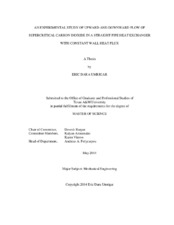| dc.description.abstract | An experimental analysis was conducted on a single circular tube heat exchanger using supercritical carbon dioxide as the working fluid. The heat exchanger was operated in two different orientations: vertically upward and downward. The experimental facility utilized two different mass flow rates: a low flow rate of 0.0183 kg/s and a high mass flow rate 0.03 kg/s, three system pressures: 7.5, 8.1 and 10.2 MPa and two different heat inputs: a low heat input of 540 W and a high heat input of 955 W. Inlet temperatures to the test section were varied from 20-55°C. Thermocouples on the surface of the test section recorded the wall temperatures. Then, a one dimensional heat transfer analysis was conducted to calculate inner wall temperatures. Afterwards, the bulk temperature was calculated using a constant heat flux approximation and an energy balance on a
differential control volume. Finally, the local heat transfer coefficient between the bulk and inner wall was calculated.
Results showed that typically, for the 7.5 and 8.1 MPa cases, as the temperature reached the pseudocritical point, there was a heat transfer deterioration followed immediately by a substantially large heat transfer enhancement. After the critical temperature was reached, however, the heat transfer coefficient decreased. The results showed that the heat transfer coefficient, deterioration and enhancement were the greatest with the 7.5 MPa case and the downward orientation. Buoyancy effects seem to be present and have a significant impact on the heat transfer coefficient.
In general, if heat exchangers are to be designed to be used with supercritical fluids, they should be designed, along with other important components, to be operated as close to the critical point as possible as well as have a downward flowing orientation to maximize heat transfer potential. | en |


